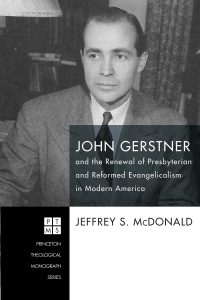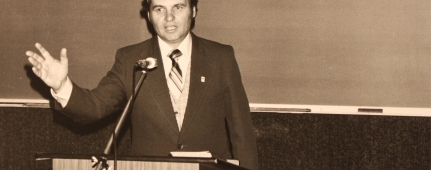Review of Jeffrey McDonald’s biography of John Gerstner
by William C. Roach
Jeffrey S. McDonald. John Gerstner and the Renewal of Presbyterian and Reformed Evangelicalism in Modern America. Eugene: Pickwick, 2017. 263 pp. $26.40.
Available at Pickwick and Amazon
The twentieth century saw a renewal of evangelical Protestant orthodoxy. It also saw the birth of heterodoxy and heresy. The twentieth century also saw the birth, ministry, intellect, and conviction of John Henry Gerstner Jr. (1914-1996). The problem with many studies from any time-period is they seemingly over emphasis and study certain individuals to the neglect of other indispensable figures. Jeffrey S. McDonald and his book, John Gerstner and the Renewal of Presbyterian and Reformed Evangelicalism in Modern America, attempt to fill the void in twentieth century evangelical scholarship pertaining to John Gerstner. McDonald states, “This study analyzes Gerstner’s life and thought in relation to the history of the mainline Northern Presbyterian church and the burgeoning evangelical movement and reveals his importance in pre- and post- World War II American religion” (p. 2). “Gerstner eschewed liberal and neo-orthodoxy theology,” says McDonald, “in an era when these two theological viewpoints dominated mainline Presbyterian seminary faculties. He could be gracious and charitable, but was uncompromising in his evangelical stance” (p. 3). Gerstner defended his convictions by drawing from a blend of Calvinistic, Old Princeton theology, and the powerful thought of Jonathan Edwards (p. 3).
McDonald’s book includes eight chapters. Each one is intended to discuss key time periods throughout Gerstner’s life and career. The first three chapters discuss Gerstner and the making of an evangelical scholar and the emergence of a Reformed professor. Chapters four and six reflect upon Gerstner’s apologetic efforts both inside the Presbyterian church and before the secular world. Chapter five connects the dots between Gerstner as an apologist and professor by discussing the various ways he shaped modern evangelicalism. Finally, chapters seven and eight discuss Gerstner’s role in the Reformed resurgence that took place in the twentieth century.
Since there are many facets to Gerstner’s life, this present review will narrow the scope by focusing upon two central themes: 1) Gerstner as the defender of biblical inerrancy; and 2) Gerstner as the heir of Edwardian and Princetonian theology and apologetics.
First, John Gerstner was an astonishingly profound lecturer and preacher. His commitment to a rational defense of the Christian faith and the clear proclamation of inspired Scripture was matched by few. Due to Gerstner’s momentous influence, he attracted students who desired to learn theology and church history at his very feet. Two students of Gerstner, who played a significant role in twentieth century thought, were R. C. Sproul and Jack Rogers. Sproul has been recognized as Gerstner’s true heir of Edwardian and Princetonian theology and apologetics. Sproul went on to found Ligonier Ministries and served as a professor at numerous evangelical institutions. Sproul would go on to play a significant role in the founding of the International Council on Biblical Inerrancy and the Chicago Statement on Biblical Inerrancy. On the other hand, Rogers played a key role as a Fuller Seminary theology professor and he worked tirelessly to move the neo-evangelical movement away from the inerrancy of Scripture (p. 6). Rogers, along with Donald McKim, published a work titled, The Authority and Interpretation of the Bible, where they argued that inerrancy is a modern convention (p. 123, 126-27). McDonald notes, “Gerstner seemed to believe that Rogers was the scholar most responsible for pushing evangelicals to the left on the issue of inerrancy” (p. 125). Gerstner accused Rogers of reducing inerrancy to a “caricature” (p. 126). He also charged Rogers as affirming “errant inerrancy,” which ought not be confused with the historic consensus on inerrancy (p. 126). Gerstner was obviously central to the inerrancy debate of the twentieth century, even if his students were divided over the doctrine. His former students, Sproul and Rogers, show the significant role Gerstner played. McDonald says, rightly, “In Gerstner’s mind, denial of inerrancy led directly to the type of progressive theological environment that Pittsburgh Seminary had produced and which he worked in, but lamented. No other scholar in American could claim to have so many of their ex-pupils fighting on the front line of the ‘Battle for the Bible’” (p. 127).
Second, Gerstner studied under John Orr at Westmont College (p. 19-49, 127). However, his first introduction to apologetics came from J. D. Adams, who was a professor of Bible at Philadelphia School of the Bible (p. 21). McDonald records that Gerstner asked Adams during a tour of the school, “What do you teach here?” (p. 21). After this question, Adams then went on to offer a thirty-minute lecture on the “content and meaning of the Bible, ‘especially the crimson stream, the Blood of Christ’ flowing through Scripture” (p. 21). McDonald notes that Gerstner walked out of that school a changed and regenerate man. That very day, Gerstner finally understood the heart of the gospel message, claiming that his time with Adams was the “most important half hour of his life” (p. 21). There is a question whether or not Adams incorporated apologetics in this encounter. Nevertheless, McDonald claims, “Perhaps Gerstner’s significant meeting with the dean led him to have a high view of apologetics” (p. 21).
Gerstner’s initial exposure to apologetics occurred at Westminster College. The primary influence upon Gerstner’s apologetic was the evidentialism he was taught by John Orr (p. 24). McDonald claims, “The Westminster [College] professor sought to defend the faith using a reasoned evidentialist apologetic. Orr was committed to the idea that Christianity needed to be defended on rational grounds” (p. 24). Not only was Orr the greatest apologetic influence upon Gerstner, he also served as a type of spiritual father to his young protégé (p. 25). Shortly after graduating, Gerstner went on to study at Westminster Theological Seminary, under the presuppositionalist apologist, Cornelius Van Til. McDonald notes, “Gerstner recalled that he was not swayed by Van Til’s approach to apologetics and held firm to the evidentialism he had imbibed from Orr” (p. 35). After seminary, Gerstner put his apologetic to the test by studying at Harvard University. There Gerstner faced great antagonism to his evangelical faith. Nevertheless, “Perhaps the best explanation for his resilience,” McDonald suggests, “is that Gerstner’s apologetic views were largely developed by the time he arrived at Harvard. . . . As a doctoral student at Harvard, Gerstner continued to stick to his apologetic guns while simultaneously deepening his grasp of philosophy” (p. 42).
Gerstner’s spiritual preparation under Adams, and his apologetic training under Orr and Van Til, prepared Gerstner to study at Harvard. Gerstner’s greatest battles, however, would come not from the secular academy. Rather, they came from his very own denomination and the seminary he taught at for several decades. Gerstner battled issues related to neo-orthodoxy, theological liberalism, councils that ordained men who denied the deity of Christ, and controversies over confessional fidelity. Even though Gerstner grew lonely and felt isolated during these battles, his convictions remained strong. He also was able to withstand the onslaught of attacks from seemingly every direction, because of his commitment to Old Princetonian theology and apologetics. Gerstner knew his theological and apologetic stance was consistent with the Reformed tradition, as he stood upon the shoulders of Edwards, Warfield, Machen, and the Westminster Confession of Faith (pp 124-28).
In conclusion, McDonald’s biography fills an intellectual gap in evangelical scholarship by surveying the life, theology, convictions, and influence of Presbyterian and Reformed Evangelicalism’s indispensable theologian and apologist—John Gerstner. McDonald has written probably the definitive biography on Gerstner, if not the exclusive biography. This book must be considered essential reading to understand the history of twentieth century evangelical theology and apologetics. The rise of evangelical orthodoxy and a strong defense of biblical inerrancy can be traced back to John Gerstner, who served as the mouth piece for both Edwards and Old Princetonian theology during an age opposed to classic Protestant orthodoxy.
William C. Roach
Southeastern Baptist Theological Seminary
Also visit https://defendinginerrancy.com///john-gerstner-biblical-inerrancy/















